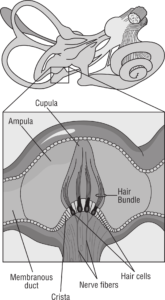What is Benign Paroxysmal Positional Vertigo?

Benign paroxysmal positional vertigo (BPPV) causes brief episodes of mild to intense dizziness. It’s usually caused by changing the position of your head, such as when you tip your head up or down, when you lie down, turn over, or sit up in bed. Sometimes, the eyes will shake rapidly making it difficult to focus on an object. These can make you feel like your head or the room is spinning. Most people will reach out to a wall or object to steady themselves.
Although benign paroxysmal positional vertigo can be a bothersome problem, it’s rarely serious except when it increases the chance of falls. You can receive effective treatment for benign paroxysmal positional vertigo during a doctor’s office visit.
Risk factors
Vertigo can occur in anyone, but it usually affects middle-aged women more than any other population. An episode of vertigo can last anywhere from a few seconds to several minutes. It can also vary in severity from mild attacks to severe attacks that cause a person to experience nausea and vomit.
- Head trauma
- Migraine
- Inactivity
- Acute alcoholism
- Major surgery
- Central nervous system disease (such as Multiple Sclerosis)
- Vertebral basilar insufficiency/stroke
- Ear disease/otitis media
- Vestibular neuritis (such as from shingles)
- Meniere’s disease
- Otosclerosis
- Vertebrogenic origin
Symptoms
The signs and symptoms of BPPV can come and go, with symptoms commonly lasting less than one minute. Episodes of benign paroxysmal positional vertigo can disappear for some time and then reoccur. Activities that bring about the signs and symptoms of BPPV can vary from person to person, but are almost always brought on by a change in the position of your head, even if you are sitting or lying down. Some people also feel out of balance when standing or walking. The signs and symptoms of benign paroxysmal positional vertigo (BPPV) may include:
- Dizziness
- A sense that you or your surroundings are spinning or moving (vertigo)
- A loss of balance or unsteadiness
- Nystagmus, an abnormal rhythmic eye movement
- Nauseas
- Vomiting
The ear’s role
Inside your ear is a tiny organ called the vestibular labyrinth. It includes three loop-shaped structures (semicircular canals) that contain fluid and fine, hair-like sensors that monitor the rotation of your head.
Other structures (otolith organs) in your ear monitor movements of your head — up and down, right and left, back and forth — and your head’s position related to gravity. These otolith organs contain crystals that make you sensitive to gravity.
For a variety of reasons, these crystals can become dislodged. When they become dislodged, they can move into one of the semicircular canals — especially while you’re lying down. This causes the semicircular canal to become sensitive to head position changes it would normally not respond to, which is what makes you feel dizzy.
When to see a doctor
Generally, see your doctor if you experience any recurrent, sudden, severe, or prolonged and unexplained dizziness or vertigo.
Treatment
Studies have shown that chiropractic treatment helps to resolve 66-92% cases of vertigo. Treatment includes neck adjustments and activites that can be done outside of a Chiropractic Physician’s office that helps increase the effectiveness of treatment. Most cases of BPPV resolve within a few weeks to a few months without recurring episodes. For the small number of patients who do not seem to respond to conservative treatment are referred to a specialist for a neurological consultation and consideration for prescription medication.
When to seek emergency care
Although it’s uncommon for dizziness to signal a serious illness, see your doctor immediately if you experience dizziness or vertigo along with any of the following signs or symptoms because they may signal a more serious problem.
- A new, different or severe headache
- A fever
- Double vision or loss of vision
- Hearing loss
- Trouble speaking
- Leg or arm weakness
- Loss of consciousness
- Falling or difficulty walking
- Numbness or tingling
With proper treatment, most patients get relief from vertigo within a few treatments. Treatment can be done in a doctor’s office and patients are often sent home with instructions for exercises than can help reduce the symptoms and frequency of vertigo episodes.


